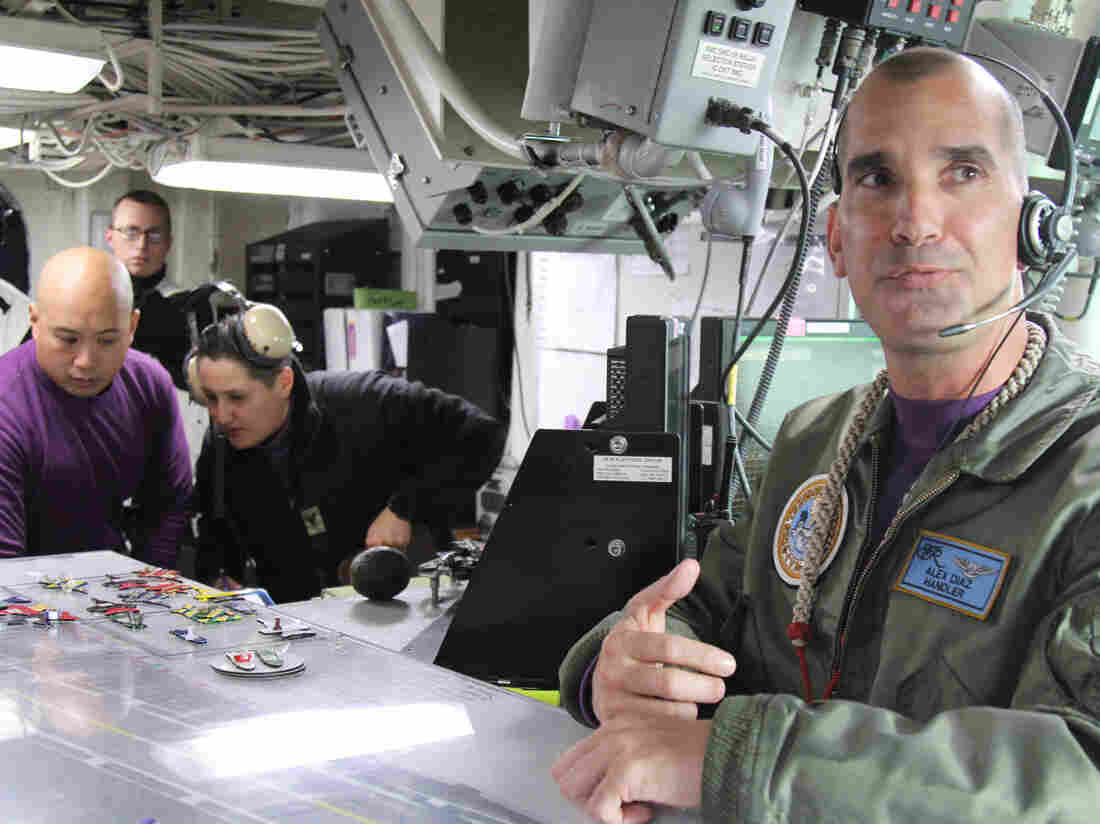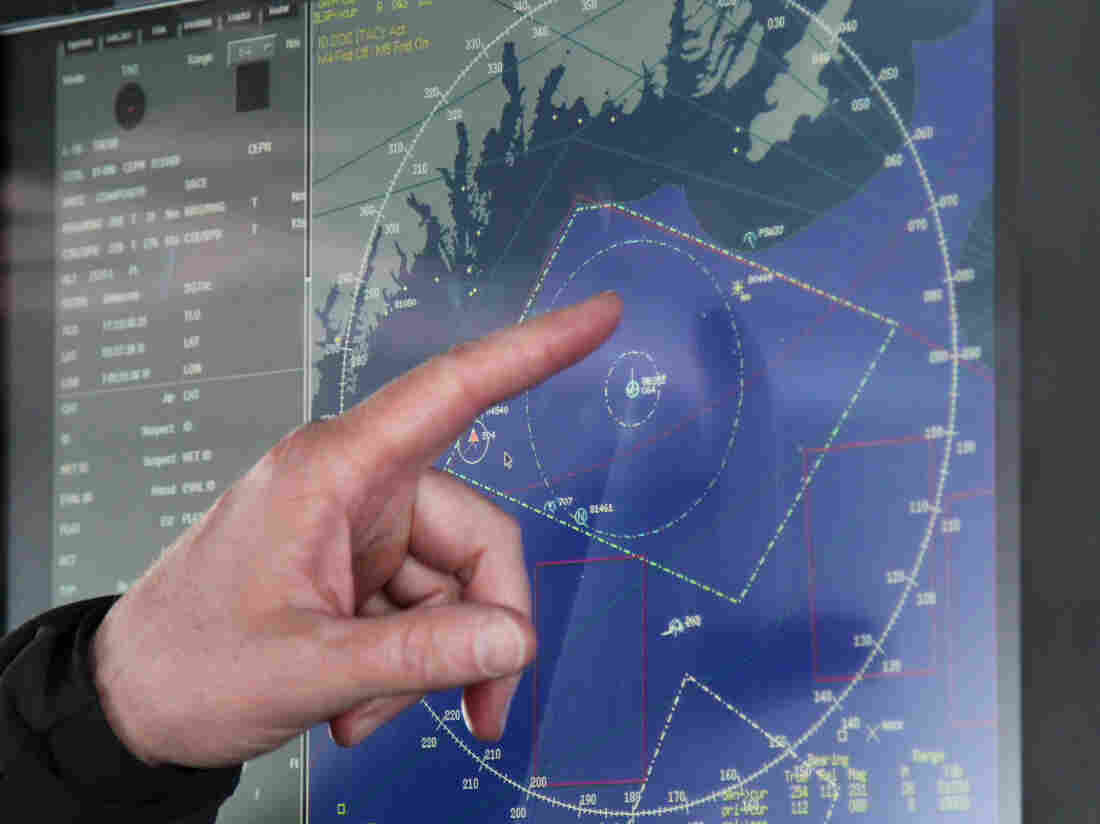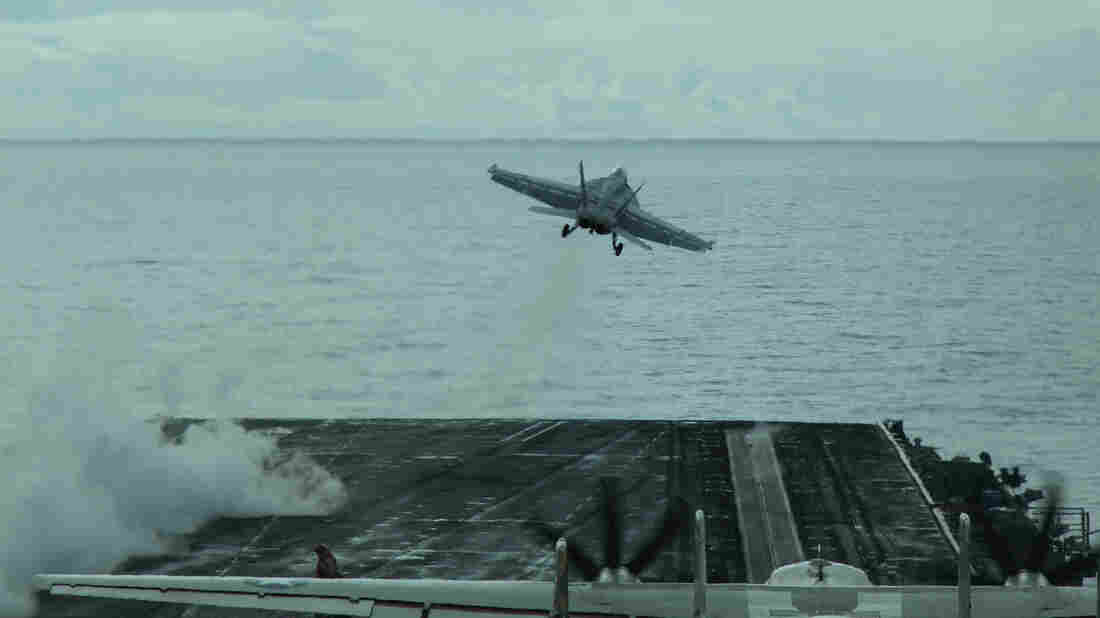
An F/A-18 Super Hornet removing prepared to fly off a USS Theodore Roosevelt in a Gulf of Alaska.
Zachariah Hughes/Alaska Public Media
hide caption
toggle caption
Zachariah Hughes/Alaska Public Media
An F/A-18 Super Hornet removing prepared to fly off a USS Theodore Roosevelt in a Gulf of Alaska.
Zachariah Hughes/Alaska Public Media
The U.S. Navy is looking north.
As meridian change melts ice that has prolonged blocked a segment off from movement and industry, a troops is reckoning out how to enhance a participation in a waters of a high north, essentially off a seashore of Alaska.
Driving a pull is that many of a blurb activity and growth seductiveness in a segment is entrance from nations a Pentagon considers rivals, such as Russia and China.
The Navy’s participation in Alaska has waxed and waned over a years. The state has abounding Army and Air Force assets, with a Coast Guard widespread throughout, as well. The Navy runs submarine exercises underneath a sea ice off Alaska’s northern coast.
But until final year, no U.S. aircraft conduit had ventured above a Arctic Circle in roughly 3 decades. The USS Harry S. Truman took partial in naval exercises in a Norwegian Sea final October, a initial such vessel to cruise that distant north given 1991.
And for a initial time in a decade, this May an aircraft conduit strike organisation — led by a USS Theodore Roosevelt — sailed to Alaska as partial of Northern Edge, a biennial large-scale troops practice that brings together organisation from all a troops branches – airmen, marines, soldiers, seamen and coasties. The Navy always participates, nonetheless this year it was out in force.

Lt. Cmdr. Alex Diaz, whose pursuit is overseeing trade on a USS Theodore Roosevelt moody deck.
Zachariah Hughes/Alaska Public Media
hide caption
toggle caption
Zachariah Hughes/Alaska Public Media
Lt. Cmdr. Alex Diaz, whose pursuit is overseeing trade on a USS Theodore Roosevelt moody deck.
Zachariah Hughes/Alaska Public Media
Rear Adm. Daniel Dwyer commands a 9 ships in a Roosevelt strike group. Speaking on an regard rug several stories above a moody deck, he pronounced meridian change is adding a new coercion to training like this one as sea activity increases in Arctic waters.
“You see a timorous of a frigid ice cap, opening of sea lanes, some-more trade by those areas,” Dwyer said. “It’s a Navy’s shortcoming to strengthen America by those approaches.”
The Defense Department views a hazard of troops dispute in a Arctic as low, nonetheless it is dumbfounded by augmenting activity in a segment from Russia and China. A 2018 report by a Government Accountability Office on a Navy’s purpose in a Arctic records that abounding healthy resources like gas, minerals and fish bonds are apropos some-more permitted as a frigid ice top melts, bringing “competing government claims.”
Defending U.S. interests in a Arctic
As a Roosevelt cruised by a Gulf of Alaska, F/A-18 Super Hornets took off and landed during a sprightly clip. Each takeoff is a full physique knowledge for those on deck, jar all from one’s boots to teeth. Planes are launched by a steam mortar complement powered by a ship’s chief reactors.
Some of a jets flew some-more than 100 miles towards mainland Alaska, and continued on past towering ranges to synch adult with Air Force and Marine Corps counterparts handling in a airspace around Eielson Air Force Base nearby Fairbanks. Then they returned to a Roosevelt. The whole outing lasts about 4 hours.

A map display a position of a USS Theodore Roosevelt in a Gulf of Alaska.
Zachariah Hughes/Alaska Public Media
hide caption
toggle caption
Zachariah Hughes/Alaska Public Media
A map display a position of a USS Theodore Roosevelt in a Gulf of Alaska.
Zachariah Hughes/Alaska Public Media
To land, a Super Hornets unexpected forsaken out of a sky swinging a offshoot that snagged during wires bringing them from full speed to full stop in 183 feet. It looked reduction like a automobile braking than a drum coaster slamming still to give riders one final jolt.
“We are throwing anywhere from 6 to 25 aircraft on this recovery,” crackled a voice over a loudspeaker on a deck. “I’m not certain nonetheless [how many]. If they uncover adult on a ball, we’re gonna locate ’em.”
The rug was concurrent chaos, with organisation members and aircraft rotating by perplexing maneuvers like a antique ballet, billows of steam from a launch apparatus intermittently billowing past.
The rug crews are referred to as “skittles” since they wear uniforms that are color-coordinated to compare their jobs. Much like a candy, many of a rainbow is represented. Greens take caring of takeoffs and landings. Reds hoop ordnance. Purples understanding with fuel and are referred to as “grapes.”
The Navy says that given what is now approaching of it in a region, crews are lerned and versed to lift out their missions as good as any other nation’s navy.
“Regardless of a conditions: day, night, good weather, bad weather, prosaic seas, complicated seas, it’s a same procession each time,” Dwyer pronounced of a jets holding off next only as a helicopter set down on a moody deck.
A changeable concentration to a “high north”
Speaking during this year’s Coast Guard Academy commencement, National Security Advisor John Bolton pronounced a troops will play a partial “reasserting” American change over a Arctic.
“We wish a high north to be a segment of low tension, where no nation seeks to require others by troops buildup or mercantile exploitation,” Bolton told graduates.
The Trump Administration is approaching to betray a new Arctic Strategy someday this June.
Forecasters expect abating ice will reliably open adult northern sea lanes that could cut down a time and cost relocating burden from Asia to Europe, causing a arise in vessel traffic.
The troops is vehement that a warming meridian is opening adult movement routes that sea-ice has prolonged sealed in. Right now, though, a U.S. naval participation is minimal.

F/A-18 Super Hornet is launched by a steam-powered mortar off a USS Theodore Roosevelt during Naval exercises in a Gulf of Alaska.
Zachariah Hughes/Alaska Public Media
hide caption
toggle caption
Zachariah Hughes/Alaska Public Media
F/A-18 Super Hornet is launched by a steam-powered mortar off a USS Theodore Roosevelt during Naval exercises in a Gulf of Alaska.
Zachariah Hughes/Alaska Public Media
“If you’re gonna be a neighbor, we have to be in a neighborhood,” pronounced Vice Adm. John Alexander, commander of a Navy’s 3rd Fleet, that is obliged for a Northern Pacific, including a Bering Sea and Alaskan Arctic.
“We’re going to have to safeguard that there’s giveaway and open movement of those waters,” Alexander said.
But a Navy faces vital impediments to expanding a participation in a nautical sourroundings as oppressive as a Arctic. According to a GAO report, many of a Navy’s aspect ships aren’t “designed to work in icy water.”
The authors note that Navy officials have settled that “contractor construction yards now miss imagination in a pattern for construction of winterized, ice-capable aspect conflicting and amphibious crusade ships.”
After years of study, a Defense Department has nonetheless to collect a plcae and pattern for a vital pier in a closeness of a Arctic that can henceforth accommodate a clever Navy presence.
And even if we can work in a Arctic, we still have to get there. For now, a region’s waters are solidly solidified over for many of a year. According to a Coast Guard, Russia has some-more than 40 icebreakers, including 3 new gargantuan nuclear-powered vessels designed to manipulate sea lanes along a northern sea route. The U.S. military, by contrast, currently has only dual operative icebreakers.
This story comes from American Homefront, a troops and veterans stating plan from NPR and member stations.
















